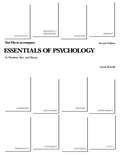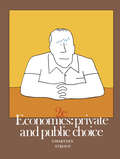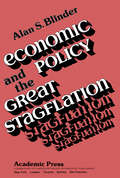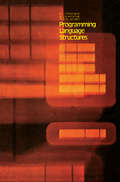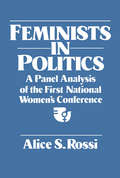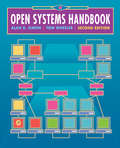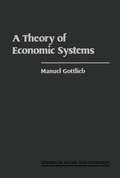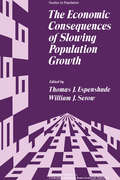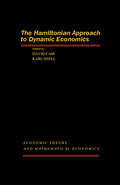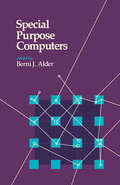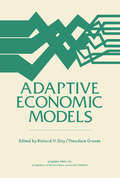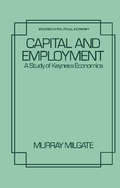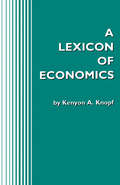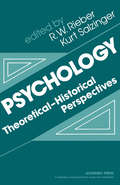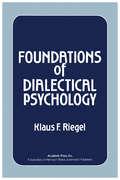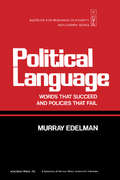- Table View
- List View
Test Booklet for Invitation to Psychology: Series II
by Victor Benassi Martin LobdellTest Booklet for Invitation to Psychology contains approximately 2000 multiple-choice questions that test mastery of the concepts and information presented in the 20 chapters and statistics appendix of Invitation to Psychology. The topics covered in these chapters include the following: the definition of psychology; the psychological basis of behavior; sensation and perception; states of awareness; learning, memory, and cognition; motivation and emotion; abnormal psychology and social behavior. In each chapter, questions are arranged in the order in which concepts are presented. The correct answer to each question is indicated by an asterisk. A text-page reference enables instructors to crosscheck from the text and to prepare tests and examinations on material that students have read. In preparing this second test file, the authors have modified or deleted those original questions that proved to be vague or difficult for students and have taken care to include a good blend of factual and conceptual questions. Although some are similar to questions in the first test file, most are new items that have been developed through the authors' own classroom use of the text and ancillary materials.
Test File to Accompany Essentials of Psychology
by Sarah RundleTest File to Accompany Essentials of Psychology
Economics: Private and Public Choice
by James D Gwartney Richard StroupEconomics: Private and Public Choice, Second Edition deals with modern Keynesian theory, monetarist theory, collective decision-making, and the traditional demand-side of macroeconomics. The book explains economic principles, such as taxation, government expenditure, public choice theory, rate of employment, aggregate supply, fiscal policy, low productivity, inflation, and adaptive expectation hypothesis. The text also covers microeconomics, particularly, capital interest, profits, energy market, and the indifference curve analysis. The book discusses inequality, income mobility, and the battle against poverty where a market system can encourage the careful use of resources, high productivity, and freedom of choice for individuals to bear the costs and reap the benefits. The text points out that income redistribution can result in some conflicts. As an example, the book analyzes income inequality in the United Sates, income inequality in other countries, as well as its causes. The book also describes the characteristics of less developed countries as having low per capita income, dominance of agriculture-household sector, rapid population growth, income that is more unequally distributed, including inadequate health care and education. The book is suitable for economists, sociologists, and policy makers involved in national economic development.
Test Booklet for Essentials of Psychology: Houston/Bee/Hatfield/Rimm
by Victor Benassi Martin LobdellTest Booklet for Essentials of Psychology contains approximately 1500 multiple-choice questions that test mastery of the concepts and information presented in the 14 chapters and statistics appendix of Essentials of Psychology. The topics covered in these chapters include the following: the definition of psychology; the psychological basis of behavior; sensation and perception; learning, memory, and cognition; motivation and emotion; development over the life span; personality theory; and abnormal psychology.In each chapter, questions are arranged in the order in which the concepts are presented. The correct answer to each question is indicated by an asterisk. A text-page reference enables instructors to cross-check from the text and to prepare tests and examinations on material that students have read.
Economic Policy and the Great Stagflation
by Alan S. BlinderEconomic Policy and the Great Stagflation discusses the national economic policy and economics as a policy-oriented science. This book summarizes what economists do and do not know about the inflation and recession that affected the U.S. economy during the years of the Great Stagflation in the mid-1970s. The topics discussed include the basic concepts of stagflation, turbulent economic history of 1971-1976, anatomy of the great recession and inflation, and legacy of the Great Stagflation. The relation of wage-price controls, fiscal policy, and monetary policy to the Great Stagflation is also elaborated. This publication is beneficial to economists and students researching on the history of the Great Stagflation and policy errors of the 1970s.
Programming Language Structures
by Elliott I. Organick Alexandra I. Forsythe Robert P. PlummerProgramming Language Structures deals with the structures of programming languages and introduces the reader to five important programming languages: Algol, Fortran, Lisp, Snobol, and Pascal. The fundamental similarities and differences among these languages are discussed. A unifying framework is constructed that can be used to study the structure of other languages, such as Cobol, PL/I, and APL. Several of the tools and methodologies needed to construct large programs are also considered.Comprised of 10 chapters, this book begins with a summary of the relevant concepts and principles about algorithms, flowcharts, and computation that a student is expected to know from the first course. The discussion then turns to the semantics of procedure and function call as well as argument-parameter matching with various kinds of parameters; recursion and its relation to tree traversal; syntax formalism for context-free languages; and ALGOL 60 and block structuring. Case study programs are presented to reinforce the reader's understanding of ALGOL 60 and Fortran semantics. The remaining chapters deal with Lisp, Snobol, and Pascal.This monograph is intended for working programmers and students in computer science who have an interest in the subject of programming.
Feminists in Politics: A Panel Analysis of the First National Women's Conference
by Alice S. RossiFeminists in Politics: A Panel Analysis of the First National Women's Conference provides a systematic study of the impact of the National Women’s Conference held in Houston, Texas, in November 1977, on the participants. It traces the past political activities of the conference participants; what they actually did during the conference; the impact of the conference on their commitment to political action in the future; and their aspirations for holding elected office in American politics or in organizations associated with the feminist movement. The volume begins by placing the IWY Commission and the study of the conference in the context of feminist history—both the long-term history that reaches back to Seneca Falls in 1848 and the short-term history of more recent post-1965 political developments. Subsequent chapters deal with design, variable measurement, and response pattern analysis; political organization and group formation; the differences between Pro-Plan and Anti-Plan activists at the conference; and the past political development of the delegates and their political aspirations. This impact analysis will be of interest to political scientists and sociologists, as well as to political activists concerned with the efficacy of alternative action strategies.
The Unreal Life of Oscar Zariski
by Carol ParikhThe Unreal Life of Oscar Zariski records the life of Oscar Zariski that is based upon Carol Parikh's interviews with his family, colleagues, students, and his own memories from tape-recorded interviews conducted before his death in 1986.This book describes Oscar Zariski's work in mathematics that perpetually altered the foundations of algebraic geometry. The powerful tools he forged from the ideas of algebra allowed him to penetrate classical problems with a clarity and depth that brought a rigor to the way algebraic geometers carry out proofs. The strength of his work was matched by his forcefulness as a teacher, and the students he trained at Johns Hopkins and later at Harvard have made essential contributions to many areas of mathematics.This publication is beneficial to students and researchers interested in Oscar Zariski’s life and work in mathematics.
Open Systems Handbook
by Alan R. Simon Tom WheelerOpen Systems Handbook, Second Edition provides an easy-to-read, thorough, and management-oriented explanation of the promises, dangers, and realities of open systems.This edition describes specific products and various open systems that have been updated to reflect the events of the mid-1990s. Emerging open technologies that either didn't exist in 1991 or were in their infancy, such as client/server middleware, are also covered.Topics include the definitions and history of open systems, open systems components, end user interaction points, and elements of open systems software. The general communications hardware, visual application development, models of integration, and advantages of open systems are likewise elaborated.This publication is a good reference for computing professionals and engineers working on open systems.
A Theory of Economic Systems
by Manuel GottliebA Theory of Economic Systems is a systematic inquiry into the nature of historical economic systems, their relationships to each other, their peripheral areas, and the ways in which they and their components have evolved over time. Topics covered include modes of production; coordination of resource use; functions of the state in the economy; and the institutions of money and property.Comprised of nine chapters, this book begins with a brief introduction to the frame of reference; basic definitions of the terms used in economic systems; methodological issues; and the bounds of the inquiry. The next chapters are devoted to modes of production or forms of productive organization. Ten distinct modes of production are identified, with different modes sometimes dominant in different fields of economic activity (agriculture, industry, wholesale trade, urban services, etc.). The way the use of economic resources is coordinated both within and between modes is considered, with particular reference to markets, rationing, and central planning. Subsequent chapters focus on the role of the state and the public economy in economic systems; money and property; the ways in which separate economic systems may be drawn into meaningful multinational gestalts or orders; and problems of system classification. The book concludes by listing eight broad family types of systems into which most, if not all, historically experienced systems may fit.This monograph should appeal to social scientists in varied fields of specialization such as geography, sociology, economic history, political science, and economics.
The Economic Consequences of Slowing Population Growth
by Thomas J. Espenshade William J. SerowThe Economic Consequences of Slowing Population Growth is a collection of papers dealing with the economic implications of a sustained low fertility rate on an industrialized country. The book reviews the situation prevailing in the United States including the country's demographic trends and prospects. The text also presents the uncertainties, the unknown, and the known economic consequences of low fertility as analyzed from previous generations. One paper examines the lessons that can be learned from a zero population growth in Europe by comparing theory and reality. This paper expounds on the social and economic effects while transitioning to a zero growth rate. Other papers examine the inter-relationships between unemployment, inflation, and economic policy. These papers also give recommendations to cut unemployment levels without causing inflation in the process. Other papers discuss social security and other needs of an aging population. One paper examines rising concerns over population movements in times of slower U.S. population growth; the author cites data reflecting migration trends and population declines in several metropolitan areas. The text can prove useful for sociologists, social workers, public health services officers, and public economists.
History of Programming Languages
by Richard L. WexelblatHistory of Programming Languages presents information pertinent to the technical aspects of the language design and creation. This book provides an understanding of the processes of language design as related to the environment in which languages are developed and the knowledge base available to the originators.Organized into 14 sections encompassing 77 chapters, this book begins with an overview of the programming techniques to use to help the system produce efficient programs. This text then discusses how to use parentheses to help the system identify identical subexpressions within an expression and thereby eliminate their duplicate calculation. Other chapters consider FORTRAN programming techniques needed to produce optimum object programs. This book discusses as well the developments leading to ALGOL 60. The final chapter presents the biography of Adin D. Falkoff.This book is a valuable resource for graduate students, practitioners, historians, statisticians, mathematicians, programmers, as well as computer scientists and specialists.
Contemporary Scientific Psychology
by Albert R. GilgenContemporary Scientific Psychology is a compendium of papers dealing with the scientific method in action in psychology. The first two papers introduce the paradigm, progress, and problems found in scientific psychology, as well as the observation, discovery, and confirmation used in theory building (including fallacies pertaining to theory construction). Other papers deal with research areas such as the neurobehavioral foundations of the biology of mind. This research area includes the mechanism-specific approaches in behavior genetics, particularly the genetic effect as such effect is considered dependent on the mechanisms altered by the environment or the genetic equivalent of a stimuli. Another paper discusses comparative psychology in studies involving animal behavior, while another author tackles the significant trends in the field of developmental psychology, especially as this relates to the early learning processes of humans. This book can be helpful for students and teachers in courses related to experimental psychology, psychological theories, philosophy of science, and other academicians and professionals who are interested in general psychology.
The Hamiltonian Approach to Dynamic Economics
by David Cass Karl ShellThe Hamiltonian Approach to Dynamic Economics focuses on the application of the Hamiltonian approach to dynamic economics and attempts to provide some unification of the theory of heterogeneous capital. Emphasis is placed on the stability of long-run steady-state equilibrium in models of heterogeneous capital accumulation. Generalizations of the Samuelson-Scheinkman approach are also given. Moreover, conditions are sought on the geometry of the Hamiltonian function (that is, on static technology) that suffice to preserve under (not necessarily small) perturbation the basic properties of the Hamiltonian dynamical system.Comprised of eight essays, this book begins with an introduction to Hamiltonian dynamics in economics, followed by a discussion on optimal steady states of n-sector growth models when utility is discounted. Optimal growth and decentralized or descriptive growth models in both continuous and discrete time are treated as applications of Hamiltonian dynamics. Theproblem of optimal growth with zero discounting is considered, with emphasis on a steepness condition on the Hamiltonian function. The general problem of decentralized growth with instantaneously adjusted expectations about price changes is also analyzed, along with the global asymptotic stability of optimal control systems with applications to the theory of economic growth.This monograph will be of value to mathematicians and economists.
Special Purpose Computers
by Berni J. AlderSpecial Purpose Computers describes special-purpose computers and compares them to general-purpose computers in terms of speed and cost. Examples of computers that were designed for the efficient solution of long established algorithms are given, including Navier-Stokes hydrodynamic solvers, classical molecular dynamic machines, and Ising model computers.Comprised of seven chapters, this volume begins by documenting the progress of the CalTech Concurrent Computation Program and its evolution from computational high-energy physics to a supercomputer initiative, with emphasis on the lessons learned including computer architecture issues and the trade-offs between in-house and commercial development. The reader is then introduced to the QCD Machine, a special-purpose parallel supercomputer that was designed and built to solve the lattice quantum chromodynamics problem. Subsequent chapters focus on the Geometry-Defining Processors and their application to the solution of partial differential equations; the Navier-Stokes computer; parallel processing using the Loosely Coupled Array of Processors (LCAP) system; and the Delft Ising system processor. The design and implementation of the Delft molecular-dynamics processor are also described.This book will be of interest to computer engineers and designers.
Adaptive Economic Models: Proceedings of a Symposium Conducted by the Mathematics Research Center, the University of Wisconsin–Madison, October 21-23, 1974
by Richard H. Day Theodore GrovesAdaptive Economic Models provides information pertinent to the adaptive processes in economics. This book discusses the developments on research in the field of adaptive economics.Organized into 23 chapters, this book begins with an overview of the study of economic processes using concepts of adaptation. This text then explains how concepts arising from biology can be formulated in such a way that they can be a source of insight into man's social systems. Other chapters present a general view of the adaptation of the firm to its environment and discuss how a firm with a definite commodity in mind can decide whether to enter a given established market. This book discusses as well the simple duopoly problem in which firms are in error in the sense that they specify an incomplete model and add a random error term. The final chapter deals with the set of models and problems for the development of a theory of money and financial institutions.This book is a valuable resource for economic theorists and economists.
Evaluation of Econometric Models
by Jan Kmenta James B. RamseyEvaluation of Econometric Models presents approaches to assessing and enhancing the progress of applied economic research.This book discusses the problems and issues in evaluating econometric models, use of exploratory methods in economic analysis, and model construction and evaluation when theoretical knowledge is scarce. The data analysis by partial least squares, prediction analysis of economic models, and aggregation and disaggregation of nonlinear equations are also elaborated. This text likewise covers the comparison of econometric models by optimal control techniques, role of time series analysis in econometric model evaluation, and hypothesis testing in spectral regression. Other topics include the relevance of laboratory experiments to testing resource allocation theory and token economy and animal models for the experimental analysis of economic behavior.This publication is intended for students and researchers interested in evaluating econometric models.
Capital and Employment: A Study of Keynes's Economics
by Murray MilgateStudies in Political Economy: Capital and Employment: A Study of Keynes's Economics focuses on the inquiry into Keynesian economics, particularly the relationship of capital and employment. The publication first underscores the contemporary position of 'Keynesian' economics, traditional long-period method of economic analysis, and theoretical systems and the long-period method. Discussions focus on the structure of classical economic theory, structure of marginalist economic theory, and the traditional long-period method of economic analysis. The text then ponders on the analysis of deviations from long-period positions, principle of effective demand, and the theory of capital and theory of employment. Topics include Keynes on the 'classical' theory of interest, capital and employment, inflexibility of money-wages, long-period theory of output and employment, and principle of effective demand.The book takes a look at the theoretical system of the treatise versus the general theory and the method of analysis in the treatise and the general theory, including the conceptual framework of the treatise on money and general theory and the natural rate of interest and level of employment.The publication is a valuable reference for economists and researchers interested in the relationship of capital and employment.
A Lexicon of Economics
by Kenyon A. KnopfA Lexicon of Economics compiles definitions and abbreviations of many commonly used economic terms and concepts.This book begins by providing a list of abbreviations, acronyms, and foreign phrases, followed by the definition of economic terms that are organized into alphabetical order. This compilation aims to address two difficulties in the idiom of economics—first is the exact use of a very specific definition for a common word that has many diverse meanings in everyday usage, and secondly, the interpretation of acronyms and abbreviations frequently used in economic and financial discussions.This monograph is suitable for professionals who want a handy, clear explanation of the economic terms they hear or read everyday.
Quantitative and Qualitative Microscopy
by P. Michael ConnMethods in Neurosciences, Volume 3: Quantitative and Qualitative Microscopy is a collection of papers that deals with microscopic techniques in statistical measures. This volume describes microscopy using sophisticated stains and dyes to advance observation of tests and experiments. Section I describes autoradiography including micro chemical methods, high-resolution autoradiography, and single- or double-label quantitative autoradiography for use in imaging of brain activity patterns or determining cerebral physiology. Section II discusses the quantification of structures through statistical and computational methods including dynamic video imaging technology. Section III explains the use of tracers, toxins, or dyes in tracing neuronal connections. One paper addresses the use of small injections of axonally transported fluorescent tracers. Section IV explains staining technology such as using the silver impregnation method for frozen sections of human nervous tissue that are gathered from tissues preserved in formalin. Section V addresses freezing techniques and those using freeze-fracture methods in neurobiology. The text also discusses cryoprotection and other freezing methods to control ice crystals found in fixed or unfixed brain tissues. Section VI presents the combined and high-resolution methods in polarization microscopy and microscopic investigations. Cellular biologists, micro-chemists, and scientific researchers in the field of micro- and cellular biology will appreciate this book.
Pattern-Directed Inference Systems
by D. A. Waterman Frederick Hayes-RothPattern-Directed Inference Systems provides a description of the design and implementation of pattern-directed inference systems (PDIS) for various applications. The book also addresses the theoretical significance of PDIS for artificial intelligence and cognitive psychology.The book is divided into eight sections. The introduction provides a brief overview of pattern-directed inference systems, including a historical perspective, a review of basic concepts, and a survey of work in this area. Subsequent chapters address topics on architecture and design, methods for accessing and controlling rule based systems, methods for obtaining adaptive behavior via rule-based systems and cognitive modeling. Constructing models of human information processing, natural language understanding and multilevel systems and complexity are described as well. The last section discusses the earlier chapters in the book and provides a unifying set of principles for the PDIS formalism.Computer scientists, psychologists, engineers, and researchers in artificial intelligence will find the book very informative.
Psychology: Theoretical–Historical Perspectives
by R. W. Rieber Kurt SalzingerPsychology: Theoretical-Historical Perspectives offers analysis, provided by different contributors, of the theoretical traditions in psychology. The compilation provides articles that discuss topics on the influences in the development of American psychology; the development of the concept of the self in psychology; the groundwork for psychology before the Civil War; and the influence of Darwin's evolutionary theories on psychology. Psychologists and students will find the book invaluable.
Foundations of Dialectical Psychology
by Klaus F. RiegelFoundations of Dialectical Psychology is a compilation of the writings of Klaus F. Riegel on dialectical psychology. The book presents chapters discussing such topics as the dialectics of human development; history of dialectical psychology; temporal organization of dialogues; and the analysis of the concept of crisis and its underlying philosophical model and ideology. Psychologists and students will find the book invaluable.
Theory of General Economic Equilibrium
by Trout RaderTheory of General Economic Equilibrium provides information pertinent to the general economic equilibrium theory. This book covers a variety of topics, including efficiency, economic systems analysis, welfare economics, and international trade.Organized into three parts encompassing eight chapters, this book begins with an overview of the theory of efficient production and growth where consumer preferences play a subordinate role. This text then examines that for the case where preferences satisfy appropriate conditions, efficiency theory is superseded as normative analysis by optimality theory. Other chapters consider the optimization of consumer preferences that leads to the decline of many families. This book discusses as well the existence of equilibrium, which is of importance to both normative and positive economics. The final chapter deals with the question of the speed with which the economic system attains its equilibrium state, which is assumed to be stationary.This book is a valuable resource for professional economists and advanced graduate students in economics.
Political Language: Words That Succeed and Policies That Fail
by Murray EdelmanPolitical Language: Words That Succeed and Policies That Fail deals with chronic inequalities of a smaller portion of the population getting more. The book discusses the persistence of poverty and greater inequalities in a democratic society such as the United States. The text reviews the chronic problems and the various beliefs found in American society, and also notes the general acceptance of the large differences in the quality of life of the people, which includes political power and autonomy. The book then defines perception of the political spectator and explains the linguistic generation of assumptions (taking for granted), linguistic reconstruction of facts (cover-ups), and the linguistic segmentation of politics (distinct from ordinary world). The text then emphasizes the language of inquiry, of authority, of participation, and of resistance as leading to free inquiry and experimentation or political loyalty. The selection can prove beneficial for political students, economists, educators, sociologists, and members of ministerial affairs related to population and economics.

